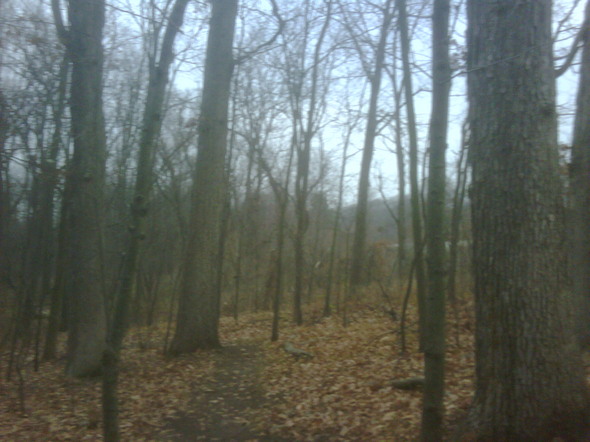A walk through the Burns-Stokes Preserve along the Huron River

A gray day in November was a lovely day to be in the Burns-Stokes Preserve, a county nature area in Scio Township with trails that go between the Huron River and the Norfolk Southern Railroad.
Edward Vielmetti | AnnArbor.com
Sunday afternoon was a good day to get out of the house for a walk in the woods. I headed west with my son to visit a park along the Huron River: the Burns-Stokes Preserve. I had read about the Burns-Stokes Preserve before, but I had never been there, so it was a bit of an adventure.
Burns-Stokes Preserve
The Burns-Stokes Preserve is a 29-acre natural area, wedged between the Norfolk Southern railroad and the Huron River, just to the west of Zeeb Road in Scio Township. There is a small parking lot which serves as a trailhead for the walking trails that go through the woodland along the river.
The location is a former mill site, though you wouldn't know it by walking around there. Time has erased the foundations of the old mill, leaving only a portion of a berm which formed the mill race.
We hiked back along the trails, which were dry and well kept but not notably paved or improved. At several places along the trail there are boardwalks that cross over seasonal streams and wetlands, and it looked like the sort of place where springtime might be muddy. About half way back the trail comes out near the railroad, and it's clear that some people use that location as an unofficial rail crossing.
I was a bit apprehensive about walking through the woods without wearing blaze orange, since it is deer season. That may be more my Upper Peninsula upbringing than anything. There is no hunting in the preserve, and we didn't hear any gunshots — just the occasional sound of traffic on Huron River Drive, the murmur of the slow-running river, and the crunch of our feet along the trail.
I'm reminded of the signature that Matthaei Botanical Gardens vistor services coordinator April Pickrel adds to her email: "Any day you can go for a walk in the woods is a GOOD DAY!" This is the sort of woods where it's hard to get lost in, since you are bounded by the river and the railroad, but easy to walk through and enjoy.
Links
Burns-Stokes Preserve, Washtenaw County. A description of the site from the Natural Area Preservation Program. An account of The Mills of Scio Village gives more history of the site.
Burns-Stokes Preserve near Dexter popular site for hiking, fishing, bird-watching, Lisa Carolin for AnnArbor.com. Somehow I missed this before I headed out — it's a good description of the site, its history, and some nice photographs below.
Scio Village: A Ghost Town with a Past, 90 Years of Forgotten History, 1827-1917 by Nicholas A. Marsh is a 1995 history of the area; the book is out of print, but available at local libraries.
Samuel W. Foster (Arborwiki page) organized the mill on the Huron River in 1835. Accounts of his life vary; to some, he was primarily a miller, erecting mills in Dexter, at Scio, and then further downstream at the location now known as Foster. To others, he is most notable for his work in the Abolition movement, with accounts of his participation in the Underground Railroad. Carol Mull's The Underground Railroad in Michigan has an account of Foster's efforts. Foster died in October 1850 in San Francisco, one of many settlers who subsequently made their way further west to seek fame in the Gold Rush.
Edward Vielmetti walks through the woods for AnnArbor.com.


Comments
Jeff Renner
Tue, Nov 23, 2010 : 10:42 a.m.
"Foster died in October 1850 in San Francisco, one of many settlers who subsequently made their way further west to seek fame in the Gold Rush." So you're saying he went further west than SF after he died?;-)